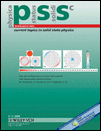Thermal expansion of RIn3 compounds with R=Pr,Gd and Lu
Abstract
Results of the linear thermal expansion coefficient α (T ) measurements for PrIn3, GdIn3 and LuIn3 are reported. These rare earth intermetallic compounds belong to a large family of RIn3 compounds which crystallize in AuCu3-type crystal structure. The measurements were made on monocrystalline samples in temperature range 5K ÷ 200 K. The compounds under investigation differ in their magnetic properties: PrIn3 is a typical example of a singlet ground-state paramagnet in which the interionic interactions are quenched by the crystalline electric field (CEF), whereas GdIn3 is the crystal-field free antiferromagnet in which the interionic RKKY interactions play essential role and cause the antiferromagnetic structure which is still unknown. The results of the measurements for LuIn3 served as a non-magnetic background for the separation of the contribution to α (T ) arising from the magnetic interaction. Theoretical considerations concerning the influence of CEF on the thermal expansion are remined. Pertinent Grüneisen parameters will be estimated in a forthcoming paper. (© 2006 WILEY-VCH Verlag GmbH & Co. KGaA, Weinheim)




